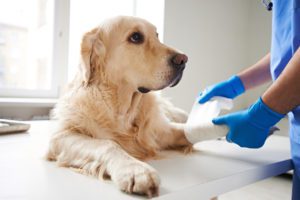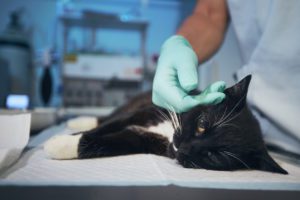How to Handle a Pet Emergency in Minnesota
A pet emergency is something that many cat owners and dog owners wouldn’t want to experience. Up to one-third of pets experience an emergency each year. But, with the quick noticing of signs, proper health care preparations, and fast action, you can help your pet get the best outcome from any emergency that occurs.

What Is a Pet Emergency?
A pet emergency could be anything abnormal that is happening with your pet. If you notice your cat or dog is showing an abnormal behavior or shows any signs/symptoms of illness, or if you notice they have injuries or open wounds, these situations are emergencies and require attention from the veterinarian. While there are some mild illnesses or injuries that can wait a while to be treated by your veterinarian during the day, there are some illnesses or injuries that are more serious and constitute a true emergency that needs to be treated no matter the time.
If you are not sure if your pet’s situation is serious, you can call your regular veterinarian (or an emergency clinic if your veterinarian is closed) and explain what is happening to your pet. Don’t always assume the situation is mild, because some illnesses that might seem easy to treat may cause harm to your pet.
Pet Emergencies That Require Immediate Care
Below are some situations that occur to pets that likely require emergency veterinary care.
- Severe diarrhea or vomiting, especially if the stool or vomiting is black or bloody. They might be suffering from abdominal pain and could have a condition such as hypoadrenocorticism, an intestinal blockage or may have gotten into a toxin.
- Difficulty breathing, abdominal distension and retching. Particularly in larger breed dogs, as this might be a sign of gastric dilation-volvulus (GDV) or bloat.
- Inability to urinate, crying in pain when attempting to urinate or defecate; blood in urine.
- Severe limping, inability to stand, walk or move, paralysis, limb positioned at an odd angle, sudden pain or anxiety.
- Seizures or convulsions
- Excessive bleeding that does not stop within 5 minutes; wound with a protruding foreign body or deep penetrating wound-especially the head, chest, or abdomen.
- Severely lethargic, unresponsive, collapse, fainting, unconscious.
- Severe allergic or anaphylactic reaction in response to insect bites, bee stings, recent vaccination, etc. – vomiting, difficulty breathing, hives, diarrhea and/or face swelling.
- Venomous snake bite
- Difficulty delivery when pregnant; high body temperature over 103F, green vaginal discharge before the first puppy or kitten is born, severe vaginal bleeding, continuous laboring without birthing (over 2 hours in a dog, over 20 minutes in a cat), unproductive and intense contractions lasting over 20 minutes in a dog or 10 minutes in a cat without birthing.
- Near drowning or aspiration.
- Blue gums, white/very pale gums, or brick or bright red gums.
- Toxin ingestion (such as toxic human foods, toxic plants, marijuana, rat bait, antifreeze, medications, snail bait, household cleaners)
- Rectal or vaginal prolapse.
- Aural hematoma (blood-filled blister on the ear flap) or ear infection that results in dizziness or the inability to stand.
- Vaginal discharge, lethargy or vomiting in an intact/unsprayed female dog or cat (could be signs of pyometra, a uterine infection).
- Thermal or chemical burns, electrocution, scalding, smoke inhalation.
- Eye injury– bleeding, squinting, or protruding of the eyeball.

Pet Situations That Can Probably Wait Until Tomorrow
Below are some situations that occur to pets that often not an immediate emergency and can be treated the next day.
- Mild swelling at the site of an insect bite or bee sting.
- Mild, infrequent vomiting or diarrhea in an otherwise healthy adult cat or dog.
- Decreased appetite (without the presence of other signs of illness).
- Mild coughing or sneezing.
- Mild ear infection.
- Broken tooth (so long as there is no other facial or oral trauma).
- Small cut or scrape; broken nail with bleeding that resolves within 5 minutes.
- Mild or occasional limping or stiffness.
- Small urinary accidents in the house without straining.
3 Steps for Handling a Pet Emergency
A pet emergency can occur anytime. Here are some steps you can take manage a pet emergency:
Stay Calm
It’s difficult to completely prepare yourself for how you’ll react when the situation happens. Although you might be stressed, if you are properly prepared you will know what to do. To prepare you should:
- Have a pet emergency kit ready ahead of time, understand how to use that basic equipment and know basic first aid techniques.
- Have the emergency veterinary clinic number in your pet first aid kit or programmed into your phone.
- Establish a relationship with a local veterinary clinic when your pet is not having an emergency and ask them how they handle pet emergencies.
- Get rid of toxic foods and substances in and around your home
Call a Pet Emergency Service
In an emergency, take the time to quickly call your regular veterinarian or an emergency service. Provide them the information you notice in your pet so it can allow them to know what they would bring, and advice you on what to do as they are arriving.
You can call any of these pet services:
- Your Regular Veterinary Clinic – Call your regular general in case your pet is experiencing any emergency.
- You’re Local Emergency Pet Hospital – If an energy has occurred and your regular veterinarian is closed, call the closest local emergency that is open 24/7.
- Pet Poison Control Hotline – You can call a pet helpline, such as the ASPCA (Animal Poison Control Center (APCC)) at 888-426-4435.
Prepare a Pet Emergency Kit
Your kit should contain the following:
- Cotton balls
- Ice pack
- Towels and washcloths
- Medical tape
- Disposable gloves
- Medical scissors
- Tweezers
- Quick read digital thermometer (normal rectal temperature in a dog/cat = 100.0-102.5 degrees Fahrenheit)
- Saline eye flush
- Artificial tears gel
- Styptic power for bleeding toenails
- Antibacterial spray or ointment
- Gauze pads and bandages
- Hydrogen peroxide 3%

Hopefully, your dog or cat would be able to face any sort of emergency. However, it is always safe to be prepared, react quickly and have the pet helpline number on hand. Try to remain calm in these situations and help your pet have a good outcome.
